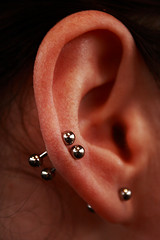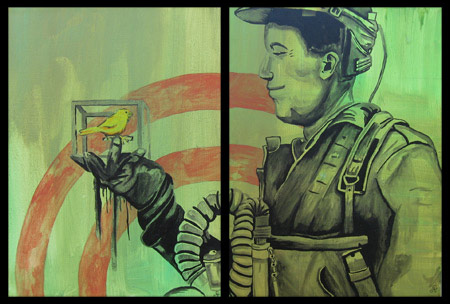So, a scientist walks into a bar . . .
 Wednesday, July 1, 2009 at 08:52AM
Wednesday, July 1, 2009 at 08:52AM I notice that researchers in Italy have published further evidence that humans show a preference for information that comes in through their right ear than that which arrives via their left. In principle this asymmetry is quite well known, and I seem to recall that this preference is not exclusive to humans.  Image by adselwood This time, however, Dr. Luca Tommasi and Daniele Marzoli from the University "Gabriele d'Annunzio" took a somewhat novel approach.
Image by adselwood This time, however, Dr. Luca Tommasi and Daniele Marzoli from the University "Gabriele d'Annunzio" took a somewhat novel approach.
While most previous studies have been based on laboratory settings, Tommasi and Marzoli took their studies to street, or rather to the nightclub. They were specifically examining if hearing through either ear is preferred for processing verbal information. What better place to test this in the “real world” than in the noisy world of the nightclub, and it’s great to think that they had a chance to have a bit of fun on the job.
In one study they observed patrons talking (over the loud music) and found that more than 70% of these conversations occurred on the right side of the listener. In the second study they approached strangers in a nightclub mumbled something in gibberish and waited to see which way the listener tilted their head to hear the question repeated. A little less than 60% offered their right ear.
In the third study they asked perfectly audible questions, but asked some to their right ear and some to their left. The questions were a request for a cigarette (these scientists are into neurology, not respiratory health) and they were offered more cigarettes from the cohort whose right ear heard the questions compared to the cohort whose left ear heard the question.
The results support earlier findings about right ear/left hemisphere advantages for verbal communication. It really is an interesting study, but I can’t help thinking about the researchers undertaking the fieldwork.
I’m really happy that these researchers got to have a night life (and that any expenses incurred are now tax-deductible) and I’m glad they secured some free cigarettes, but asking for a cigarette might be misconstrued, at least in a nightclub – it’s like buying a drink or asking someone in “for coffee”. There’s no mention of whether there is a correlation between the ear through which someone hears a question and the hand they choose to slap the questioner with. Perhaps more importantly there is no mention of how many hopeful clubbers had their hopes dashed when a gorgeous scientist asked them for a cigarette and then simply walked away. That’s cold. The study was published in Naturwissenschaften and you can read more about it here.
Canaries, Chemists and Quantum Mechanics
 Monday, June 15, 2009 at 06:41AM
Monday, June 15, 2009 at 06:41AM I presented a short piece on ‘Einstein-a-go-go’ linking canaries (specifically those in coal mines) to some important advances in chemistry. It goes a little something like this . . .
Most people are familiar with the concept of the “canary in a coal mine”. The phrase refers to the miners’ technique of carrying a canary in a cage to warn of adverse conditions as they moved through a mine. If the canary stopped singing, fell off it’s perch, died or was generally in distress (aside from what you might expect of a small bird placed in a cage and taken underground) this was an indicator that the miners might have come across an area of changed atmospheric conditions. Other animals were also used, but canaries are particularly sensitive to some gases including carbon monoxide and methane – both of which can occur in mines - especially if there has been a fire or explosion.  Image by Alex Clauss
Image by Alex Clauss
If a change in the atmosphere in a mine was detected there were 2 main concerns: that reduced oxygen might lead to asphyxiation or that flammable gasses (such as methane) might cause an explosion, an eventuality made more likely by the use of open flames as a source of illumination. Either eventuality would spoil your day.
Even before miners starting taking canaries into mines efforts were being made to make the whole enterprise safer.
In 1815, Humphry Davy (assisted by Michael Faraday) developed a safety lamp, known as the Davy lamp. The Davy lamp is basically a candle enclosed inside a fine mesh. This mesh screen acts as a flame arrestor. Firedamp (any of the various harmful vapours produced in mines, most commonly methane) can pass through the mesh, but the holes are too fine to allow a flame to propagate through them and cause an explosion. However the flame itself can change in appearance in response to changing gas concentration, alerting the miner to possible danger.
But in 1828 Faraday developed a new version of the Davy lamp (what Bill Gates would have called version 1.2.1). Basically he’d added a movable conical chimney-pot at the top of the lamp, allowing greater control over the mixing of gas and air. Apparently this idea didn't really catch on, at least in mining settings.
Meanwhile, in laboratory settings, a number of chemists had used the idea of the Davy lamp to control the mix of gas and air and thus the specific characteristics of the flame. Previous flame sources, such as furnaces, charcoal burners, spirit lamps and coal gas all had their drawbacks, so scientists were keeping their eyes open for better alternatives. When the University of Heidelberg hired a new professor in 1852, they promised to build him new laboratories. As part of this process the new professor asked the University’s mechanic, Peter Desaga, to design a prototype flame system, based in part of Michael Farraday’s design of more than 25 years earlier.
The design that Desaga produced featured slits for air at the bottom of a cylindrical burner, with the flame igniting at the top. This generated a hot, sootless, non-luminous flame by mixing the gas with air in a controlled way before combustion. His boss, a Professor Robert Bunsen was very satisfied. By the time the building opened early in 1855, Desaga had made fifty of the burners for Bunsen's students. Bunsen published a description two years later, but neither he nor Desaga actually patented it.
Bunsen found that when he fed solutions of metals into the new flame, they emitted spectacular colours. Bunsen’s friend, Gustav Kirchoff, realised that the coloured light could be analysed using a prism. This lead to the development of spectroscopy (and spectroscopes).
Spectroscopy and research on spectral lines by scientists including Niels Bohr (who won a Nobel Prize for his work in this area) lead to greater understanding of the structure of atoms and events on a sub-atomic scale.
This in turn (eventually) led to quantum theory and quantum mechanics, but that’s another story . . .
As it happens canaries were still being used in coal mines as recently as the mid-1980s.
